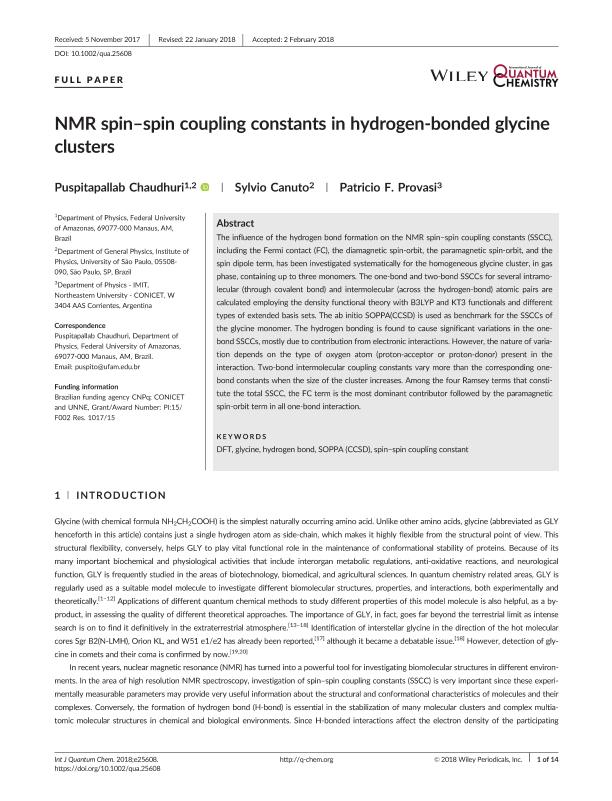Mostrar el registro sencillo del ítem
dc.contributor.author
Chaudhuri, Puspitapallab
dc.contributor.author
Canuto, Sylvio
dc.contributor.author
Provasi, Patricio Federico

dc.date.available
2019-10-21T18:11:46Z
dc.date.issued
2018-08
dc.identifier.citation
Chaudhuri, Puspitapallab; Canuto, Sylvio; Provasi, Patricio Federico; NMR spin–spin coupling constants in hydrogen-bonded glycine clusters; John Wiley & Sons Inc; International Journal of Quantum Chemistry; 118; 15; 8-2018; 1-14
dc.identifier.issn
0020-7608
dc.identifier.uri
http://hdl.handle.net/11336/86674
dc.description.abstract
The influence of the hydrogen bond formation on the NMR spin–spin coupling constants (SSCC), including the Fermi contact (FC), the diamagnetic spin-orbit, the paramagnetic spin-orbit, and the spin dipole term, has been investigated systematically for the homogeneous glycine cluster, in gas phase, containing up to three monomers. The one-bond and two-bond SSCCs for several intramolecular (through covalent bond) and intermolecular (across the hydrogen-bond) atomic pairs are calculated employing the density functional theory with B3LYP and KT3 functionals and different types of extended basis sets. The ab initio SOPPA(CCSD) is used as benchmark for the SSCCs of the glycine monomer. The hydrogen bonding is found to cause significant variations in the one-bond SSCCs, mostly due to contribution from electronic interactions. However, the nature of variation depends on the type of oxygen atom (proton-acceptor or proton-donor) present in the interaction. Two-bond intermolecular coupling constants vary more than the corresponding one-bond constants when the size of the cluster increases. Among the four Ramsey terms that constitute the total SSCC, the FC term is the most dominant contributor followed by the paramagnetic spin-orbit term in all one-bond interaction.
dc.format
application/pdf
dc.language.iso
eng
dc.publisher
John Wiley & Sons Inc

dc.rights
info:eu-repo/semantics/openAccess
dc.rights.uri
https://creativecommons.org/licenses/by-nc/2.5/ar/
dc.subject
DFT
dc.subject
GLYCINE
dc.subject
HYDROGEN BOND
dc.subject
SOPPA (CCSD)
dc.subject
SPIN–SPIN COUPLING CONSTANT
dc.subject.classification
Física Atómica, Molecular y Química

dc.subject.classification
Ciencias Físicas

dc.subject.classification
CIENCIAS NATURALES Y EXACTAS

dc.title
NMR spin–spin coupling constants in hydrogen-bonded glycine clusters
dc.type
info:eu-repo/semantics/article
dc.type
info:ar-repo/semantics/artículo
dc.type
info:eu-repo/semantics/publishedVersion
dc.date.updated
2019-10-18T15:46:29Z
dc.identifier.eissn
0020-7608
dc.journal.volume
118
dc.journal.number
15
dc.journal.pagination
1-14
dc.journal.pais
Estados Unidos

dc.description.fil
Fil: Chaudhuri, Puspitapallab. Universidade de Sao Paulo; Brasil
dc.description.fil
Fil: Canuto, Sylvio. Universidade de Sao Paulo; Brasil
dc.description.fil
Fil: Provasi, Patricio Federico. Universidad Nacional del Nordeste; Argentina. Consejo Nacional de Investigaciones Científicas y Técnicas. Centro Científico Tecnológico Conicet - Nordeste. Instituto de Modelado e Innovación Tecnológica. Universidad Nacional del Nordeste. Facultad de Ciencias Exactas Naturales y Agrimensura. Instituto de Modelado e Innovación Tecnológica; Argentina
dc.journal.title
International Journal of Quantum Chemistry

dc.relation.alternativeid
info:eu-repo/semantics/altIdentifier/doi/http://dx.doi.org/10.1002/qua.25608
dc.relation.alternativeid
info:eu-repo/semantics/altIdentifier/url/https://onlinelibrary.wiley.com/doi/abs/10.1002/qua.25608
Archivos asociados
